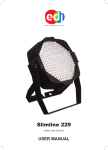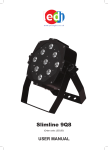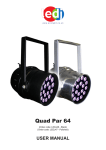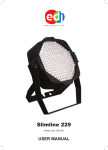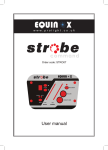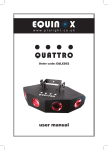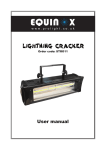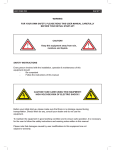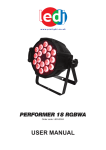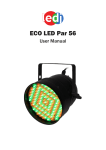Download TRI LED-56 CAN USER MANUAL
Transcript
w w w. p r o l i g h t . c o . u k TRI LED-56 CAN USER MANUAL Order code: LEDJ38 - Black Order code: LEDJ39 - Polished Tri LED-56 Can Safety WARNING FOR YOUR OWN SAFETY, PLEASE READ THIS USER MANUAL CAREFULLY BEFORE YOUR INITIAL START-UP! CAUTION! Keep this equipment away from rain, moisture and liquids. SAFETY INSTRUCTIONS Every person involved with the installation, operation & maintenance of this equipment should: - Be competent - Follow the instructions of this manual CAUTION! TAKE CARE USING THIS EQUIPMENT! HIGH VOLTAGE-RISK OF ELECTRIC SHOCK!! Before your initial start-up, please make sure that there is no damage caused during transportation. Should there be any, consult your dealer and do not use the equipment. To maintain the equipment in good working condition and to ensure safe operation, it is necessary for the user to follow the safety instructions and warning notes written in this manual. Please note that damages caused by user modifications to this equipment are not subject to warranty. Tri LED-56 Can Safety IMPORTANT: The manufacturer will not accept liability for any resulting damages caused by the non-observance of this manual or any unauthorised modification to the equipment. • Never let the power-cable come into contact with other cables. Handle the power-cable and all mains voltage connections with particular caution! • Never remove warning or informative labels from the equipment. • Do not open the equipment and do not modify the equipment. • Do not connect this equipment to a dimmer-pack. • Do not switch the equipment on and off in short intervals, as this will reduce the system’s life. • Only use the equipment indoors. • Do not expose to flammable sources, liquids or gases. • Always disconnect the power from the mains when equipment is not in use or before cleaning! Only handle the power-cable by the plug. Never pull out the plug by pulling the power-cable. • Make sure that the available voltage is between 220v/240v. • Make sure that the power-cable is never crimped or damaged. Check the equipment and the power-cable periodically. • If the equipment is dropped or damaged, disconnect the mains power supply immediately. Have a qualified engineer inspect the equipment before operating again. • If the equipment has been exposed to drastic temperature fluctuation (e.g. after transportation), do not switch it on immediately. The arising condensation might damage the equipment. Leave the equipment switched off until it has reached room temperature. • If your product fails to function correctly, discontinue use immediately. Pack the unit securely (preferably in the original packing material), and return it to your Prolight dealer for service. • Only use fuses of same type and rating. • Repairs, servicing and power connection must only be carried out by a qualified technician. THIS UNIT CONTAINS NO USER SERVICEABLE PARTS. • WARRANTY; One year from date of purchase. OPERATING DETERMINATIONS If this equipment is operated in any other way, than those described in this manual, the product may suffer damage and the warranty becomes void. Incorrect operation may lead to danger e.g.: short-circuit, burns, electric shocks, lamp failure etc. Do not endanger your own safety and the safety of others! Incorrect installation or use can cause serious damage to people and property. Tri LED-56 Can Technical specifications You should find inside the LEDJ carton the following items: 1, Tri LED-56 Can 2, Instruction manual Technical Specifications: DMX channels: 6 9 x Ultra Bright 3W Tri-colour LEDs 3-pin XLR in/out sockets 400Hz flicker free Power supply: 240V Power consumption: 41W Dimensions: 342 x 249 x 171mm Weight: 2.8Kgs Operating modes: 1, Static colour 2, Auto run 3, Colour fade 4, Sound active 5, Master/slave 6, DMX Overview: 3 7 5 8 1, DMX output 2, DMX input 3, LED display 4, Fuse (2A) 5, Mode selection button 6, Up button 7, Down button 8, Enter button 4 1 6 2 Tri LED-56 Can Operation Operation: There are 6 different operation modes to choose from: 1) Static colour mode 2) Colour change mode 3) Colour fade mode 4) Sound active mode 5) DMX mode 6) Slave mode 1, Static colour mode Mode button - Press the “MODE” button under the LED display, to show “C000”, then press the “ENTER” button to choose one of the static colours using the “UP” and “DOWN” buttons. The “C1” represents Red, “C2” = Green, “C3” = Blue and “CF” = strobe. The two digits after it are the brightness 00 to 99 or in “CF” they are the strobe speed. Examples: If you set C1, C2 and C3 to zero, the Tri LED-56 can will have no LEDs on (blackout). If you set C1 to 99 and C2 and C3 to zero, the Tri Par will be 100% Red. NOTE: For static selection of Red, Green, and Blue, ensure that the unwanted colours are set to “00”. 2, Colour change mode Mode button - Press the “MODE’ button until the LED display shows “J000”, then press the “ENTER” button to choose one of the colour changing modes using the “UP” and “DOWN” buttons. The colour change programmes are as follows: 1, “J300” = RGB, 2, “J700” = 7 colour, 3, “JF00” = Strobe, Now press the “ENTER” button again and you can then select the colour change speed using the “UP” and “DOWN” buttons. The speed settings are from 00-99 (00 = slow, 99 = fast) 3, Colour fade mode Mode button - Press the MODE button until the LED display shows “F000”, then press the “ENTER” button to choose one of the colour fading modes using the “UP” and “DOWN” buttons. The colour fade programmes are as follows: 1, “F300” = RGB, 2, “F700” = 7 colour, 3, “FF00” = Strobe, Now press the “ENTER” button again and you can then select the colour fade speed using the “UP” and “DOWN” buttons. The speed settings are from 00-99 (00 = slow, 99 = fast) 4, Sound active Mode button - Press the “MODE” button until the LED display shows “S000”, then press the “ENTER” button to choose one of the sound active modes using the “UP” and “DOWN” buttons. 1, “S300” = RGB, 2, “S700” = 7 colour Now press the “ENTER” button again to set the sensitivity level from 00-99 using the “UP” and “DOWN” buttons. (00 = low, 99 = high) Note: To confirm the setting in any of the above mode always press the “ENTER” button a final time so that the LED display stops flashing. Tri LED-56 Can Operation 5, DMX Addressing mode To access the DMX address mode, press the “MODE” button until the LED display shows “A001”, and use the “UP and “DOWN” buttons to select the desired DMX address and press the “ENTER” button to confirm the setting. Then follow the DMX channel assignment and function table below. 6. Master/Slave mode Link the units together using a 3-pin DMX cable, then press the “MODE” button to select one of the above modes. On the Slave units press the mode button until the LED display shows “SLAV”. The Slave units will then follow in sequence with the Master unit. 6 Channel DMX chart Channel Value Function 1 000-255 Master dimmer 2 000-255 Red (0 - 100%) 3 000-255 Green (0 - 100%) 4 000-255 Blue (0-100%) 0-4 No function 5-84 Colour macro 85-169 Colour jump 170-255 Colour fade 0-255 Strobe 5 6 Tri LED-56 Can DMX Set up DMX-512: • DMX (Digital Multiplex) is a universal protocol used as a form of communication between intelligent fixtures and controllers. A DMX controller sends DMX data instructions form the controller to the fixture. DMX data is sent as serial data that travels from fixture to fixture via the DATA “IN” and DATA “OUT” XLR terminals located on all DMX fixtures (most controllers only have a data “out” terminal). DMX Linking: • DMX is a language allowing all makes and models of different manufactures to be linked together and operate from a single controller, as long as all fixtures and the controller are DMX compliant. To ensure proper DMX data transmission, when using several DMX fixtures try to use the shortest cable path possible. The order in which fixtures are connected in a DMX line does not influence the DMX addressing. For example; a fixture assigned to a DMX address of 1 may be placed anywhere in a DMX line, at the beginning, at the end, or anywhere in the middle. When a fixture is assigned a DMX address of 1, the DMX controller knows to send DATA assigned to address 1 to that unit, no matter where it is located in the DMX chain. DATA Cable (DMX cable) requirements (for DMX operation): • The Tri LED-56 Can can be controlled via DMX-512 protocol. The DMX address is set on the back of the unit. Your unit and your DMX controller require a standard 3-pin XLR connector for data input/output (figure 1). Figure 1 Further DMX cables can be purchased from all good sound and lighting suppliers or Prolight dealers. Please quote: CABL10 – 2M CABL11 – 5M CABL12 – 10M Also remember that DMX cable must be daisy chained and cannot be split. Tri LED-56 Can DMX Set up Notice: • Be sure to follow figures 2 & 3 when making your own cables. Do not connect the cable’s shield conductor to the ground lug or allow the shield conductor to come in contact with the XLR’s outer casing. Grounding the shield could cause a short circuit and erratic behaviour. Special Note: Line termination: • When longer runs of cable are used, you may need to use a terminator on the last unit to avoid erratic behaviour. Termination reduces signal transmission problems and interferance. it is always advisable to connect a DMX terminal, (resistance 120 Ohm 1/4 W) between pin 2 (DMX-) and pin 3 (DMX+) of the last fixture. Using a cable terminator (part number CABL90) will decrease the possibilities of erratic behaviour. 5-Pin XLR DMX Connectors: • Some manufactures use 5-pin XLR connectors for data transmission in place of 3-pin. 5-Pin XLR fixtures may be implemented in a 3-pin XLR DMX line. When inserting standard 5-pin XLR connectors in to a 3-pin line a cable adaptor must be used. The Chart below details the correct cable conversion.









